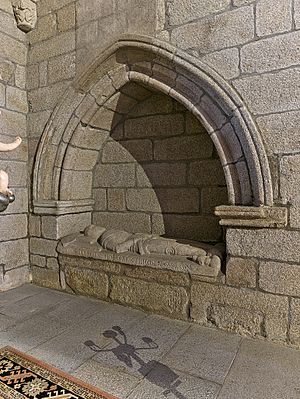Juan Pardo (explorer) facts for kids
Juan Pardo was a Spanish explorer from the 1500s. He led a Spanish journey from the Atlantic coast into what is now North and South Carolina. His travels also took him into eastern Tennessee.
Pardo was sent by Pedro Menéndez de Avilés. Menéndez wanted Pardo to find a land route to a silver mining town in Mexico. This was important for Spain to protect its valuable silver.
Before Pardo's journey, Menéndez had built Fort San Felipe in 1566. He also started the settlement of Santa Elena. These were the first Spanish settlements in what is now South Carolina. They were located on Parris Island.
As Pardo explored inland, he founded Fort San Juan at Joara. This was the first European settlement in the interior of North Carolina. It existed from 1567 to 1568. Pardo also built five more forts further west.
Contents
Pardo's Expeditions in the New World
Juan Pardo led two main expeditions from Santa Elena. He explored the interior of what is now the southeastern United States.
First Journey: Seeking Food and Bases
Pardo's first journey lasted from December 1, 1566, to March 7, 1567. He traveled with 125 men. Their main goals were to find food and set up bases. They wanted to build good relationships with the Native American groups in the area.
During this trip, Pardo established Fort San Juan. This fort was built at Joara, a major Native American center. Joara was near what is now Morganton, North Carolina. Pardo claimed this area for Spain. He renamed the settlement Cuenca, after his hometown in Spain. He left a group of soldiers to guard the fort.
Second Journey: Exploring the Interior
Pardo's second expedition began on September 1, 1567. It ended on March 2, 1568. This time, he explored the Piedmont region. He also traveled south along the Appalachian Mountains.
He built five more forts to the west of Joara. These forts were meant to help create a land route to Zacatecas. Zacatecas is in present-day Mexico. It was a place where the Spanish had important silver mines. The Spanish mistakenly thought the Appalachian Mountains connected to mountains in central Mexico.
Pardo had to return to Santa Elena when he heard about a French attack there.
End of the Forts
Later in 1568, the Native Americans in the interior turned against the Spanish. They attacked Pardo's forts. Almost all of the 120 Spanish soldiers were killed. All six forts were burned down.
After this, Spain did not try to colonize the interior of North Carolina again. Today, archaeologists are still studying the Joara and Fort San Juan sites.
Archaeological Discoveries
Since 1986, archaeologists have been working at the Berry Site. This site is near Morganton, North Carolina. They have found exciting evidence of the past.
They discovered signs of ancient mound culture. They also found burned huts and Spanish items from the 1500s. Many experts agree that this is the exact location of Joara and Fort San Juan.
In 2007, archaeologists fully dug up one of the burned huts. Inside, they found pieces of Spanish ceramic olive jars. They also found iron plates from 16th-century armor. These items are typical of what Pardo's expedition would have used.
Juan Pardo's Later Life
In 1569, Juan Pardo left the Florida colony and went back to Spain. Not much is known about his life or death after that time.
See also
 In Spanish: Juan Pardo (explorador) para niños
In Spanish: Juan Pardo (explorador) para niños


